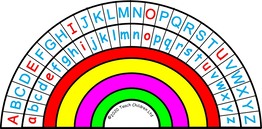Alphabet Letters
Why do we need to know the alphabet letter names?
Teaching the unique letter names of the alphabet is an important pre-phonics skill.
A letter or combination of letters can represent more than one sound and so the only way of identifying alphabet letters when we talk about them is to use their unique names.



It may seem easier to use one of the sounds a letter represents at first, but it soon becomes more complicated. For example, the letter ‘a’ makes different sounds in the words ‘ant’, ‘angel’ and ‘wash’; to name but 3 of its 8 sounds.
You can only know the sound a letter represents when it is placed in a word.
Learning the correct letter names helps to reinforce that when talking about the letter ‘a’ (ay) for example it has a set shape regardless of the sound that it will be representing in the word.
This further supports children’s handwriting development as the communication of your requirements is unambiguous.
Teaching the alphabet
Although songs and rhymes are a good way of helping your child learn the alphabetical order, rote learning by itself is not enough.
It is important that your child learns that there are 26 letters of the alphabet and that they are used in different orders to represent all the words in the English language and that the letters of the alphabet can be split into two main groups, vowels (red letters) and consonants (blue letters). Being able to identify the vowel letters will help your child when they move on to phonics.
Understanding that lower-case letters and their capital letter partners share the same unique name and represent sounds in exactly the same manner is vital. It is amazing how many children think that lower-case letters represent the sounds only and capital letters are used to show the letter names, even though they can quite happily tell you when they need to use capital letters.
Children need to be able to instantly recognise and identify letters of various fonts and this is best achieved through different games and activities. Learning through a variety of different games and activities not only prevents your child getting bored of the necessary over-learning process, but also exposes them to a wider range of learning styles.


